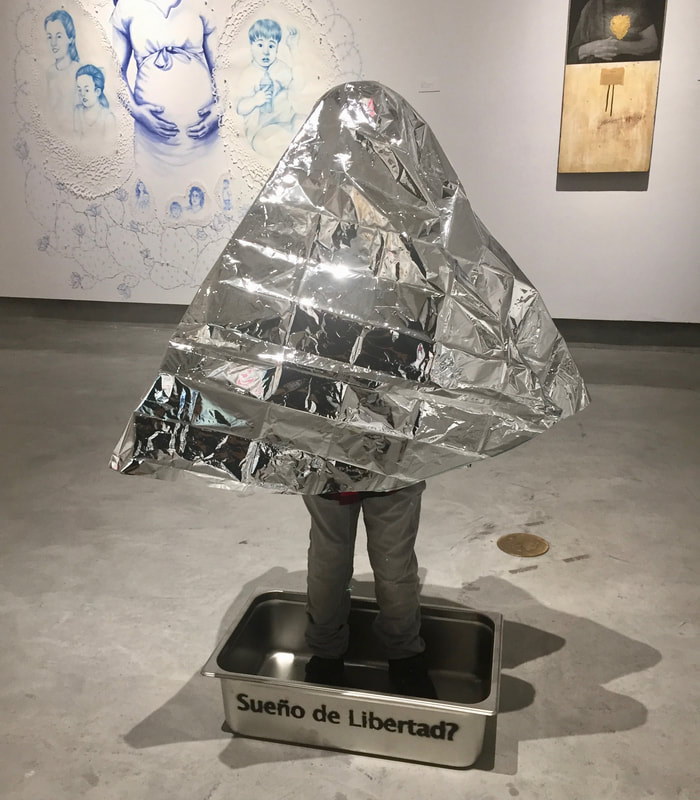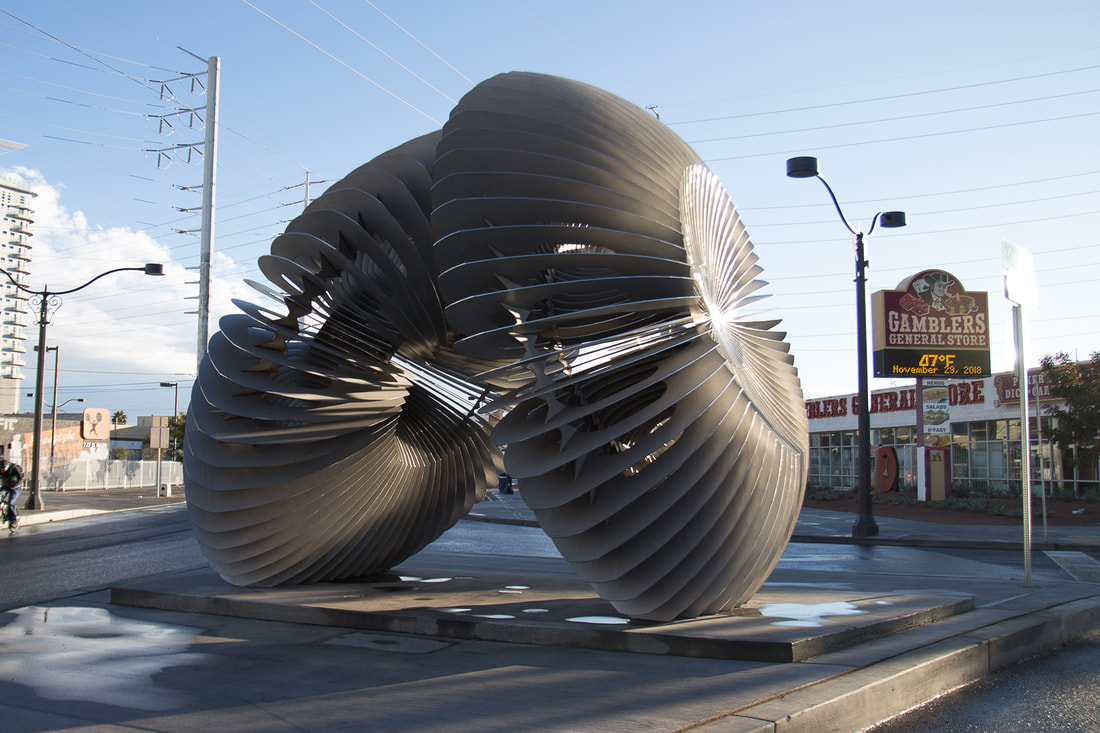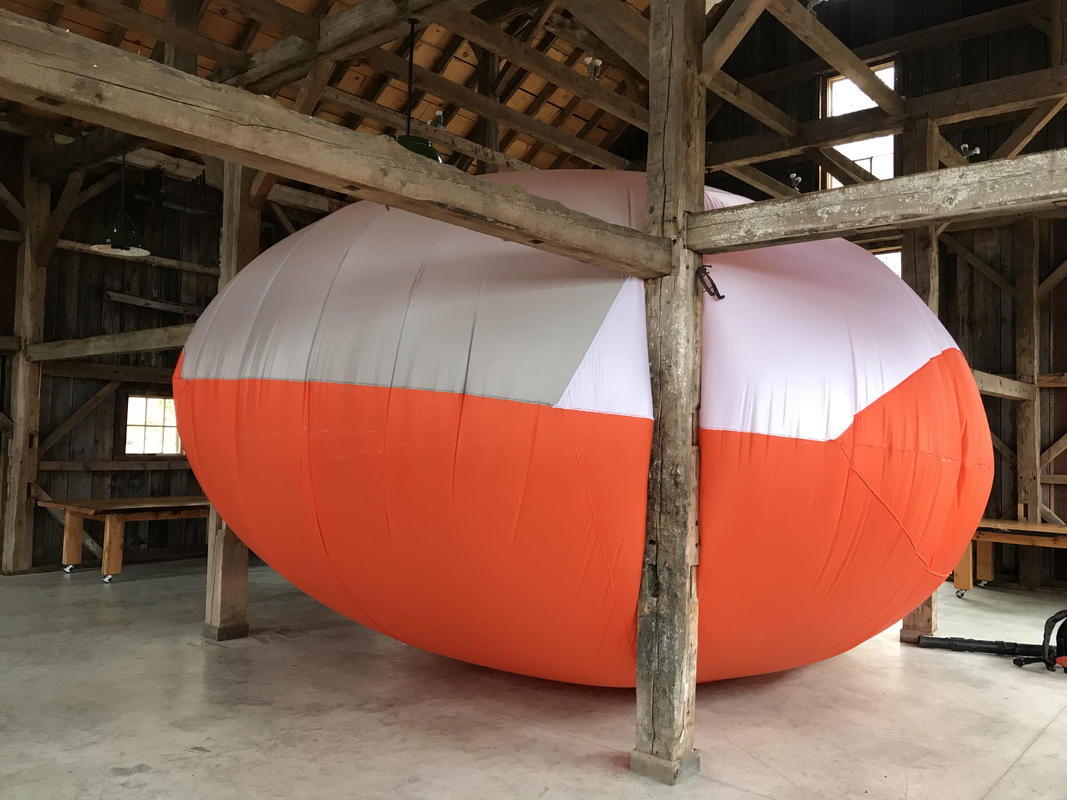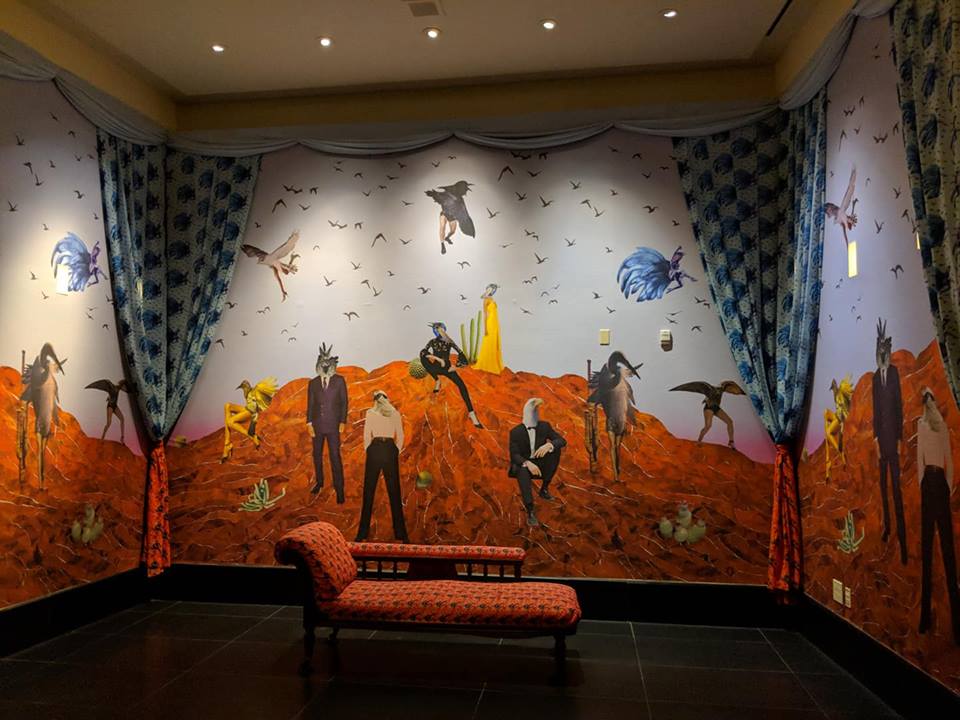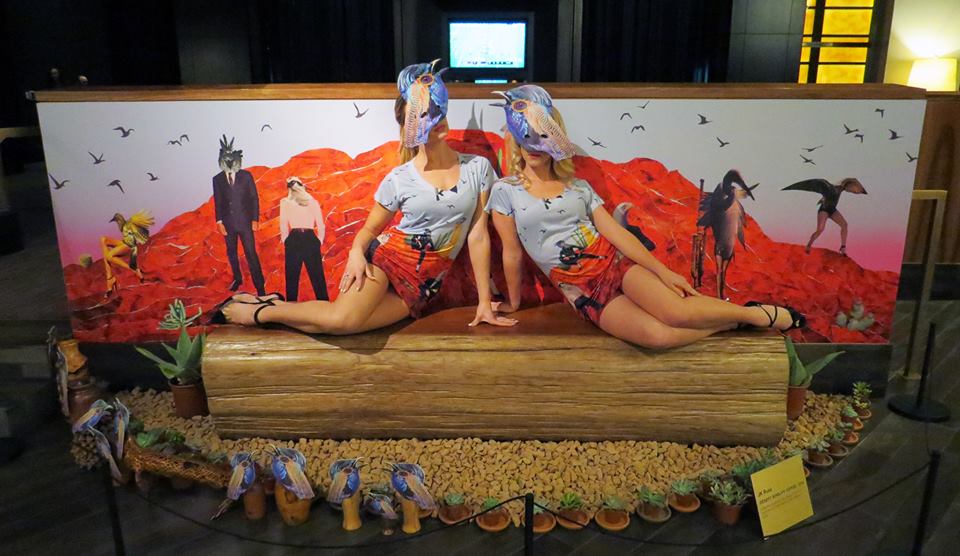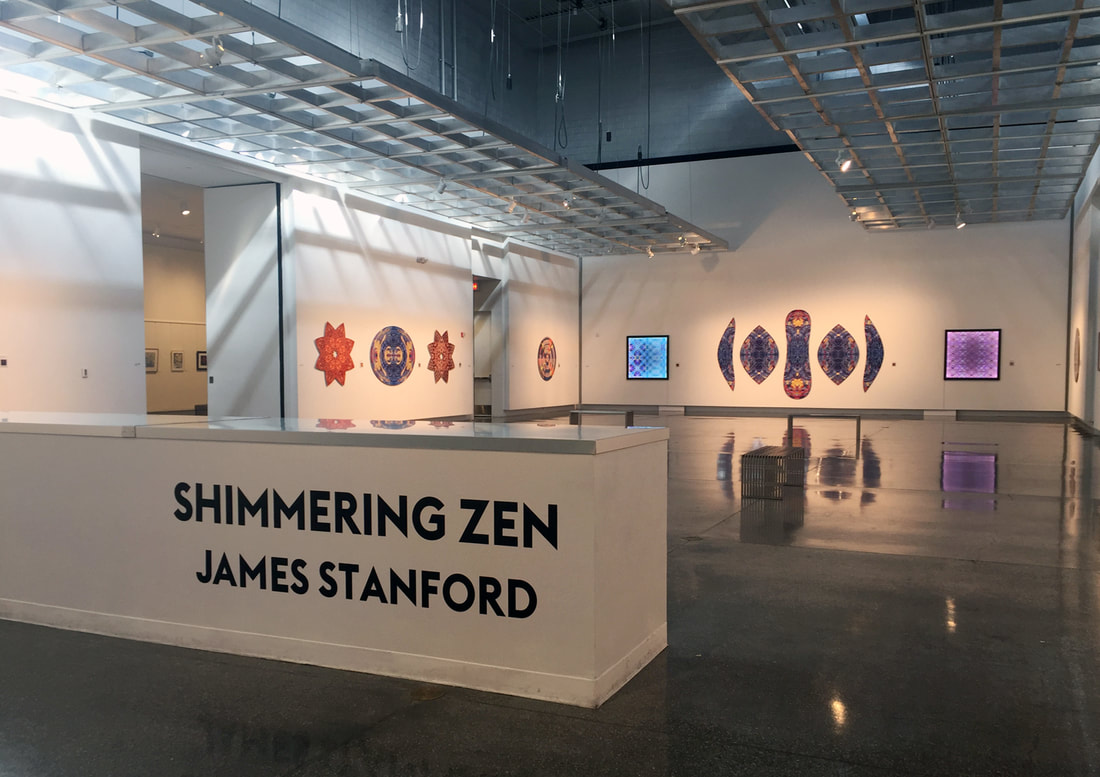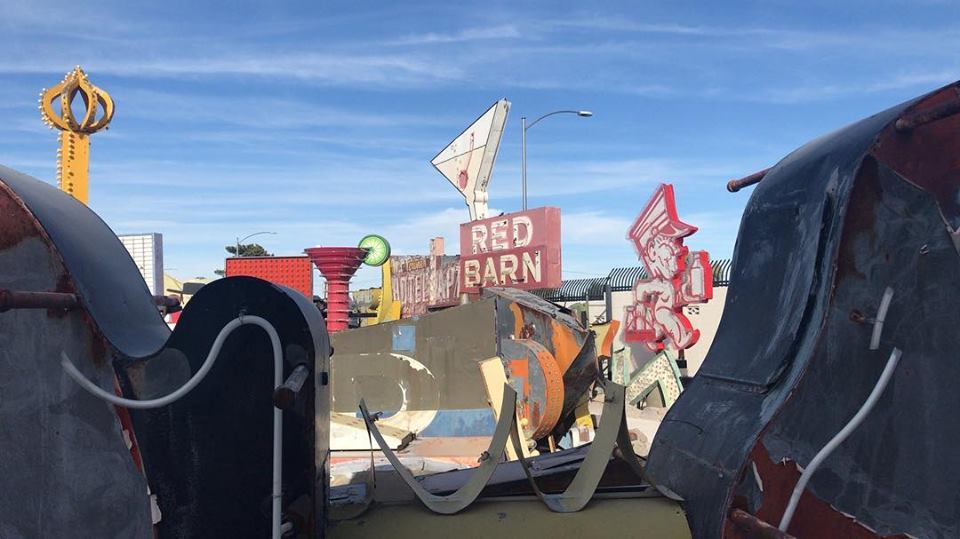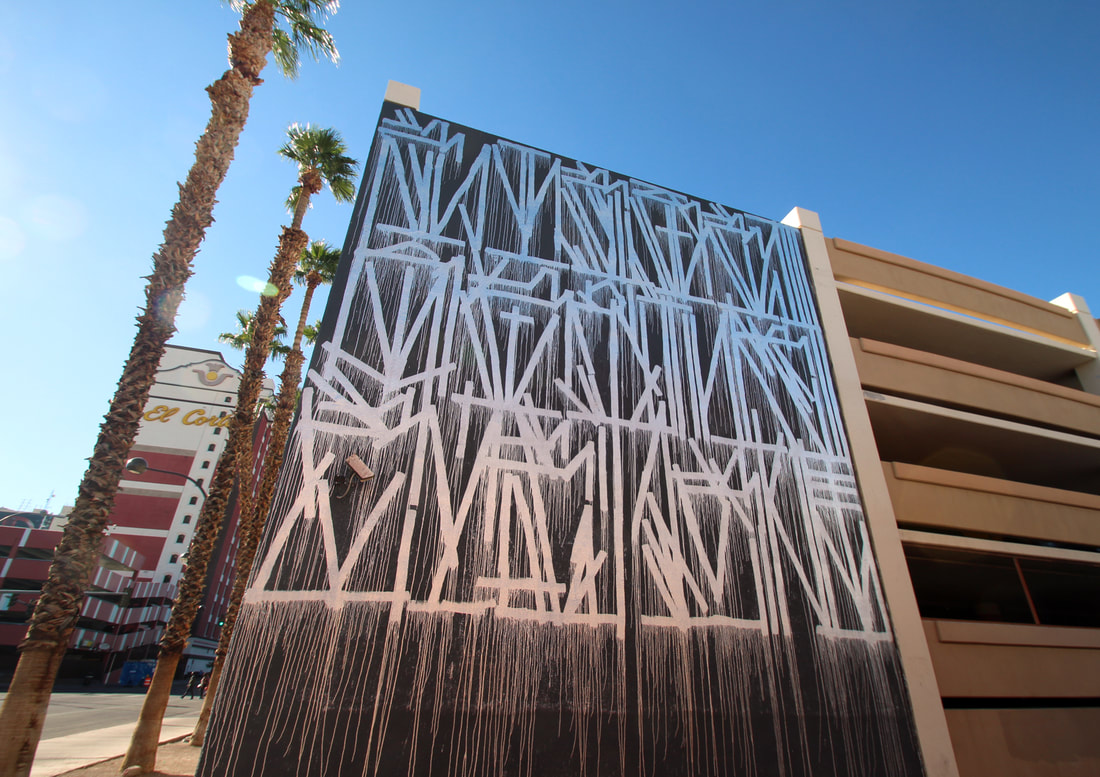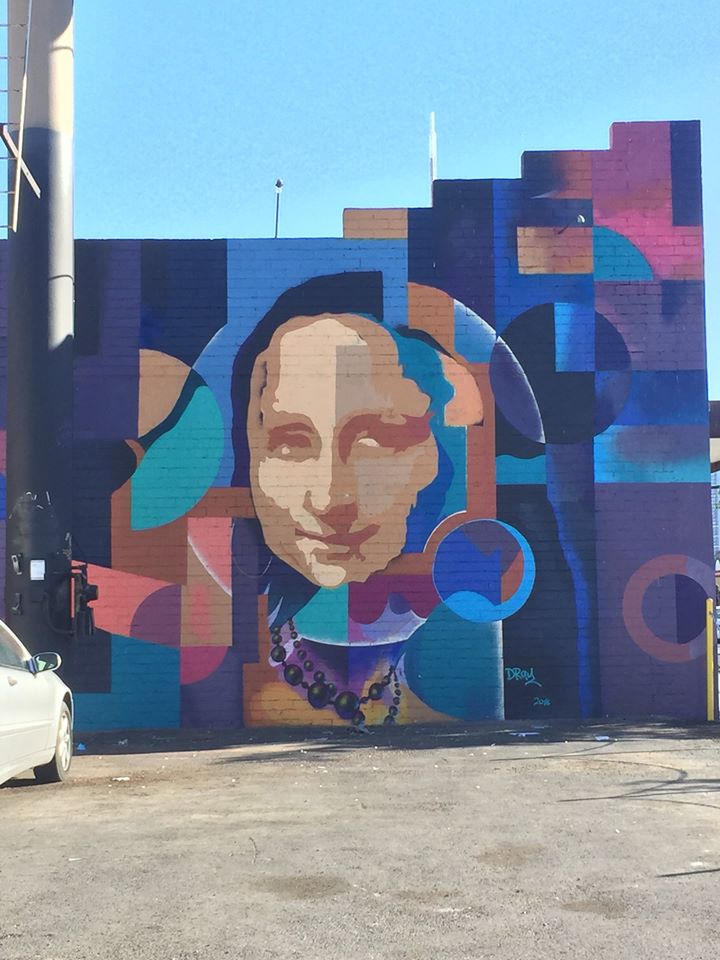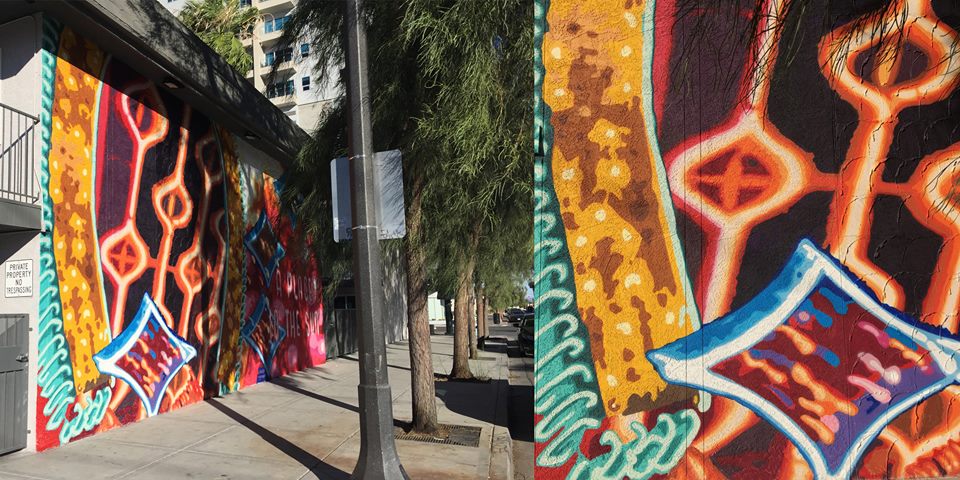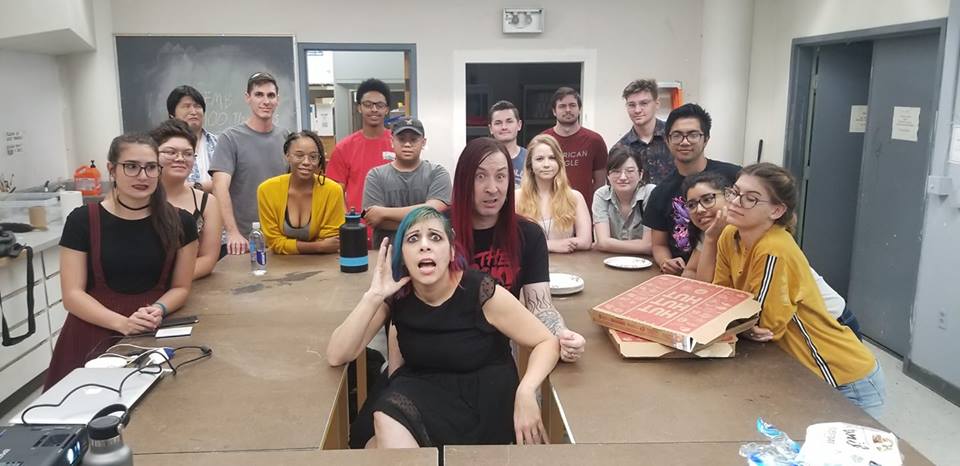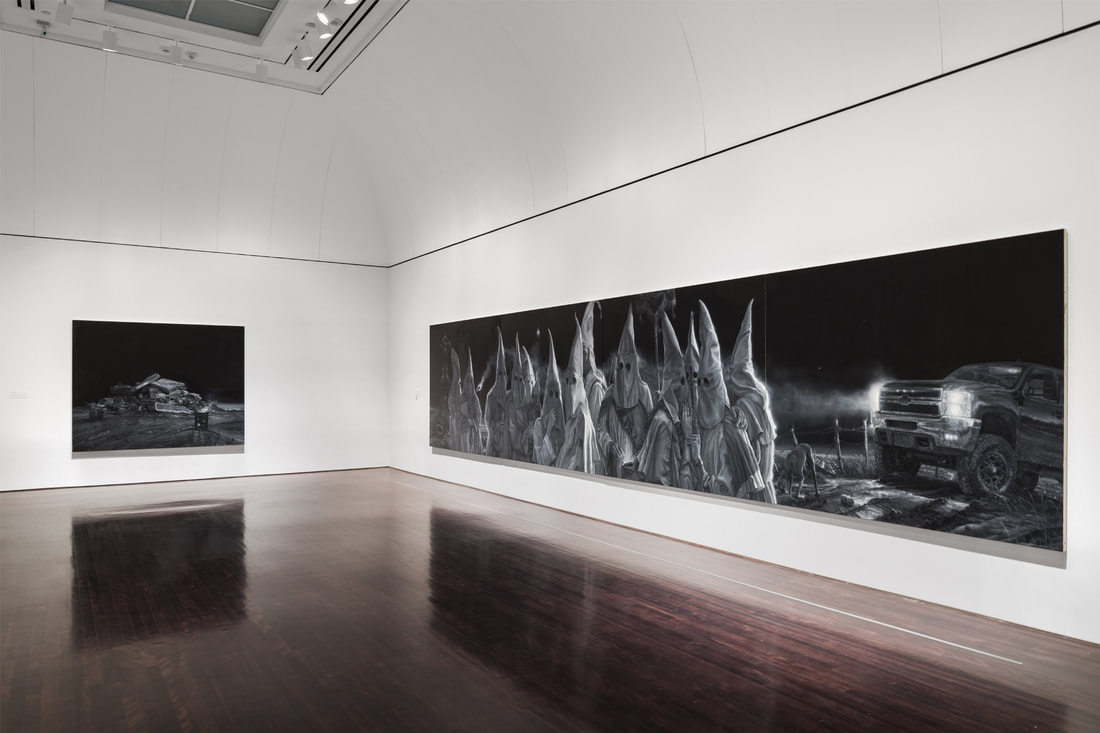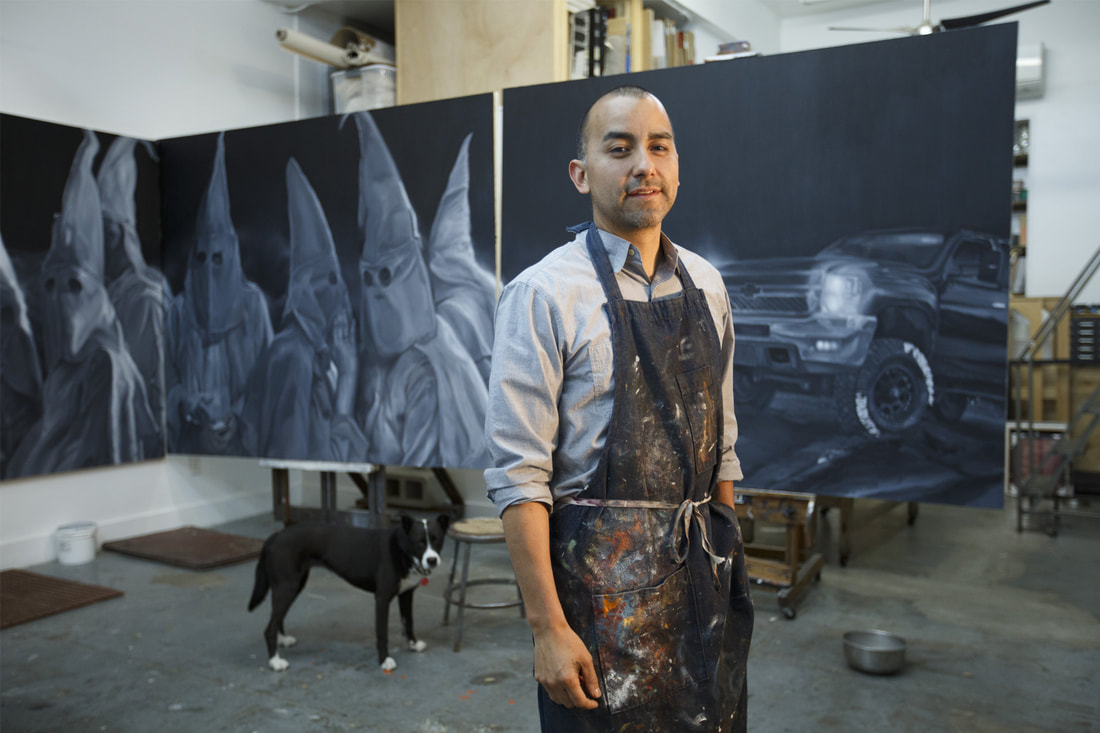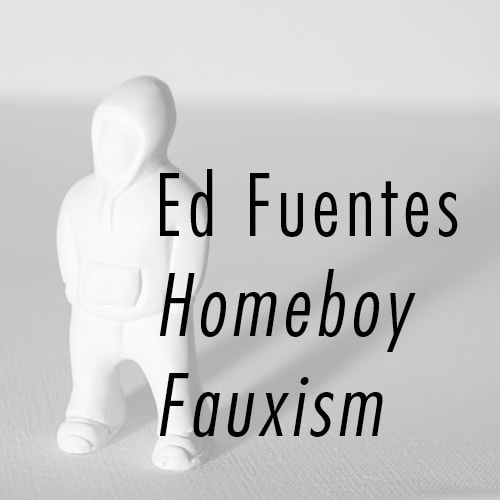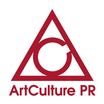|
“Security Blanket” (2018) by Luis Varela-Rico in “¡Americanx!” at Donna Beam Fine Art Gallery. An artist snuck a child past the borders of academic infused art. It was “Security Blanket” (2018) by Luis Varela-Rico, as seen during the run of “¡Americanx!” at Donna Beam Fine Art Gallery from October 1 through November 21. That was the lone figure standing in the midst of visual conversations by other artists, many who graduated from UNLV, or teach within the Nevada Higher Education system. “Security Blanket” was one of a number of art objects seen in “¡Americanx!” Varela-Rico’s sculpture, or installation, can be read as a small boy, a safe presumption by the diminutive size and smaller version of an outfit that refers to male field workers, and what is worn during late-night migration to the U.S. The piece spoke not just to policy, but the collective experience of watching televised news reports of minors separated from parents attempting to cross the border into the U.S. Varela-Rico keeps the topic visible, even as attention of left-behind children has slipped away due the noise of White House policy and tweeting. Varela-Rico’s art wasn't just an artist’s interpretation of slipping in unnoticed. This entry came in after the opening. It was a late add. Not from disenchantment by the artist of being part of the exhibition, but having to work through a busy schedule of producing large-scale public art sculptures. Yet, in its simplicity, “Security Blanket” added a needed bite of social-justice-authenticity to “¡Americanx!” On the small figure a plaid workmen shirt is just visible, so clothing becomes code for seeking labor. The pattern and material is often worn by immigrants to cope with the weather, and a subtle wardrobe item that refers to protection. There is the obvious symbol of protection; an emergency thermal blanket, as those supplied when children are in holding pens. The “boy” stood inside an industrial steam table pan. That the only part of this work that was unclear. (1) One cannot tell it was meant to be reference as an anticipated tool of kitchen prep, an implied barrier to the art, or a thread to the artist’s previous works in metal. What is clear was the writing on the pan, Sueno de Libertad, or “Dream of Freedom.” With “Security Blanket” positioned in the open space of the gallery it gained deeper meaning when viewed with “Entre Espinas Florece Esperanza” in the background. Jess Vanessa’s mural featuring an expectant mother added a reference to others who may be affected by the politics Varela-Rico is referring to. On its own “Security Blanket” is an emblem of the political wall built from ongoing GOP campaign promises made to red states and is a comment to the mandates pushed forth by Stephen Miller, the political advisor of current immigration policies. Miller has been accused as being an advisor of hate and isolation, a hunter that uses gestures of authority, like having children confiscated from anyone attempting to enter the country with them if they do not adhere to his interpretation of immigration law. That method became a warning shot and talking point: Dreaming of freedom may cost you your child. The installation, or sculpture, made of real objects and clothing is a dream interrupted. The child is made anonymous by a thermal blanket over his head, and he waits to be shuffled off next by immigration authorities. The piece, and its relationship to other works in the exhibition stayed on my mind after “¡Americanx!” closed. Always present in Varela-Rico’s work is a committed to craft that can be complicit to cultural systems that intersect in unexpected places. His metal origami birds hung on random power lines was a form of street art infiltration. Near the City of Las Vegas City Hall, a pair of 16-foot stainless steel forms are framed as Southern Paiute baskets, a public art reminder of the original administrators of the region. “Security Blanket” political statement is an powerful use of a collective conscience that shared the larger media experience of seeing footage of children lined up like small prisoners steered into U.S. makeshift facilities. The work reminds us that minors are still a symbiosis between a voting base and a White House administration. All of the artworks on view revealed how social and political commentary is the readymade for Latino/a/x artists. In this piece we are reminded of the aftermath of legislation can change a person from its original function, to hope and dream, into an object controlled by those who enforce policy. Legs visible under the silver that reflects sun and light, the artist may also be saying that the government use of shiny objects distracted some to think children were being cared for. That had the work give larger context in this exhibition of works by local Latino artist who had different experiences living in the American West. The child, and the family that brought him here, wanted to be part of that experience. Here he is portrayed as being hidden in plain sight and unable to witness the conversations around him. The young prisoner of politics is patiently waiting to be shuffled into the next room. (1) Luis Varela-Rico writes in to say "The steel container, which had an American flag sticker on it, was meant to represent being contained within metal." 'Radial Symmetry'
0 Comments
Courtesy the artist
"Jubilation Inflation" is the Tamar Ettun's solo show at the UNLV Barrick Museum of Art, the anchor exhibition for the Second Annual College of Fine Arts Art Walk on October 12. "This is the culmination of the five years color project and the first time all four inflatables are shown together," says the artist on Facebook. "The name for the exhibition is taken from a poem [On Orange] by Rose McLarney, who wrote me this beautiful piece about orange and let us include it." At 6:30 p.m. College of Fine Arts Dean Nancy J. Uscher will toast Las Vegas arts community at The Barrick. The art walk goes on until 9 p.m. (The Beam hosts ¡Americanx!)
Photo: Jo Russ
Jo Russ "Desert Birdlife Soiree" opened at Delano Las Vegas. Her vivid collage work is now an installation that allows guests to interact in the lobby with this art-as-immersion experience. Runs through January. Instagram hashtags are #jkruss #delanoartseries #desertbirdlifesoiree
Photo: Jo Russ
Photo: PaintThisDesert
The Studio at Sahara West Library is filled with works from James Stanford for "Shimmering Zen." The exhibition features his landmark digital collages that revisit neon signs and Las Vegas landmarks as a source (metaphor) of personal spirituality. Resource Magazine Online has an extensive interview with Stanford.
Los Angles media covered "The Las Vegas Portraits Project, 1 October Memorial Exhibit" at Clark County Rotunda Gallery. "Artists from America and Canada and as far away as Greece and Peru chose their subjects based on news articles and photos published after the attack." A special ceremony will be held on October 4.
Geoff Carter interviewed Justin Favela during his East Coast gallery tour. Las Vegas Weekly .
Photo: The Neon Museum.
Photo: PaintThisDesert
RETNA's large-scale letterforms are one of the leave-behind murals in downtown Las Vegas. My first pass to see new murals in the Life is Beautiful footprint reveals there are not many new works. No surprise since wall space is getting scarce. If you missed it, Bordalo II was interviewed via email by the LasVegas Review Journal, and a preview at Las Vegas Weekly that later confirms two projects were down after the festival ended September 22.
Photo: PaintThisDesert
Jerry Misko's new mural Casino Center and Hoover in Downtown Las Vegas. The phrase at the end is "A Place in the Sun." I am guessing that is the title of this new "Misko."
OUTSIDE LAS VEGAS
Above: Tagging with light.
- ModernMet compiled Instagram images from Burning Man 2018.
- "Far from the established New York design world, California became a haven for avant-garde designers, a hub of innovation in both discourse and practice." West of Modernism: California Graphic Design, 1975–95 opens at LACMA
- Ai Weiwei is in Los Angeles. The Los Angeles Times has a profile by Deborah Vankin and a review by Christopher Knight. - The J. Paul Getty Trust now has the papers of the pioneering assemblage artist Betye Saar, and with that came the news the Getty Research Institute will begin The African American Art History Initiative - New York Times - Grandest U.S. show to date of Victor Hugo drawings opens this week at The Hammer Museum. It has an "unprecedented" number of loans from Bibliothèque Nationale (18) and Maison de Victor Hugo (25) I Art Newspaper - "Art, science and skateboarding were the magic combination of interests that propelled Halloran into her life as an artist." James Daichendt on artist Lia Halloran, who began her residency at Lux Art Institute I San Diego Tribune - Jean-Michel Basquiat's life to become a Broadway musical. "The production will have access to both Jean-Michel’s art and personal archives (which is likely to make for some pretty extraordinary sets)." I ArtNet
- Projections on buildings became video public art. Twice. Chicago and Los Angeles,
- ArtPrize Public Projects returned for its third year. - Dartmouth College to move a set of racially insensitive murals that offended Native American students to an off-campus storage facility I USNews - East coast writer takes a look at street art murals in Curaçao 'cause the weather is warmer there. I Forbes - You have seen it, but here it is again. Brett Kavanaugh Senate testimony was mash-upped with Jules pre-hit speech in "Pulp Fiction." Samuel Jackson approved.
FINAL NOTE
As seen on instagram. When critiquing a project using street art themes you must bring in qualified vandals. Sage Sage and Shawn Gatlin came to my 2D Basic class at UNLV to see student work that are a response to campus safety (and a few other topics). The work will seen during UNLV College of Fine Arts Annual Art Walk in undisclosed locations.
Installation view of Vincent Valdez: The City at the Blanton Museum of Art, The University of Texas at Austin, 2018. Purchase through the generosity of Guillermo C. Nicolas and James C. Foster in honor of Jeanne and Michael Klein, with additional support from Jeanne and Michael Klein and Ellen Susman in honor of Jeanne and Michael Klein, 2017. © Vincent Valdez Revisiting Vincent Valdez’s The City: Critical Moments of Silence and Reflection in Times of Distortion and Chaos By ANDREA LEPAGE Vincent Valdez’s “The City” has received a wide array of media coverage since its opening at the Blanton Museum of Art on July 17, 2018. In October 2016, I wrote a piece for PaintThisDesert when "The City" was on view at the David Shelton Gallery in Houston, Texas. Since then, the Blanton Museum of Art (UT Austin) purchased Valdez’s 30-foot-long painting depicting fourteen members of the Ku Klux Klan who stand in as allegorical representations of a longstanding and prevailing system of white supremacy in the United States. The hooded baby—cradled in a mother’s arms—leaves the viewer with the uncomfortable reminder that hate is transmitted seamlessly from one generation to the next. The intimidating hooded figures loom larger-than-life over the viewer and nearly obscure the distant gleaming city from which the composition takes its name. I pointed out in an essay written for the Blanton Museum’s gallery guide that Valdez’s painting calls for a visual comparison between overt and easily recognizable forms of racism (the Klan) and more covert and hidden forms (the city plan). Valdez’s inscription, “For PG & GSH,” located in the lower right corner acknowledges the prevalence of both manifestations. In paying homage to Philip Guston’s 1969 “City Limits” and Gil Scott-Heron’s 1980 visceral rendition of The Klan, Valdez inserts himself into a multi-generational artistic lineage alongside a painter and a musician who also opposed the Klan and their ideology. Vincent Valdez in his studio, 2016. © Michael Stravato “I hold very firm in my belief today that art and artists can still play a social role and that art can provide very crucial, critical moments of silence and reflection during moments of immense distortion and chaos.” - Vincent Valdez When the viewer confronts Valdez’s monumental painting, the eye first settles and lingers on the Klan members, infamous for their systematic and deadly targeting of mainly African American communities but also Latinos, Catholics, Jewish people, immigrants, and members of the LGBT community. Valdez discussed the disjunction between the beauty of their rendering and the horror of the Klan’s actions with journalist Maria Hinojosa of NPR’s “Latino USA” on the opening night at the Blanton Museum of Art. “Full blown raw reality is supposed to hit you. I lure you in with that beauty and I keep you there just enough so that you aren’t distracted within two seconds and back on your cell phone,” Valdez said. “If I can keep your attention, draw you in and keep you there, then that’s when the power of art really starts to unfold because you start to think critically.” Should attention shift to a cell phone, viewers will be met with a disconcerting reflection of themselves in the image of a Klansman who casually checks his phone. Close looking through the peaked hoods brings into high relief the significance of the gridded city in the background. Like the Klan members whose images encapsulate many forms of overt racism, the portrait of the city in the distance also assumes an allegorical role in the painting. City designs throughout the country play a key part in the systematic disenfranchisement of communities of color and immigrants. In discussing the point with Hinojosa, Valdez targeted a few of the many elements that are part of a whole system that disadvantages communities of color. County jails, high-density housing projects, and liquor stores are disproportionately placed in low income neighborhoods. Access to high-quality educational and health resources, on the other hand, are largely absent from the same communities. Underscoring the invisibility of some parts of the larger system of disenfranchisement, Valdez questioned, “Who gets trees and parks and playgrounds? Who gets access to these things?” His question conjures the image of the toddler whose pointing gesture seems to recruit the viewer to participate in a lifestyle that will ultimately support his ability to thrive. The Blanton Museum of Art also purchased the pendant piece, “The City II” (2016), which features a desolate dumping ground populated by abandoned mattresses, furniture, and television sets. “The City II” has received significantly less attention than its more jarring companion piece, yet, it is crucial in understanding a key theme that unites the multi-panel installation: American consumerism directly supports the maintenance of white supremacy. The iPhone, baby Nikes, special edition Budweiser beer can, and late model Chevrolet serve to locate the painting in the present. But these details set alongside the cast off possessions piled high in “The City II” also remind the viewer that the American drive to consume exacerbates and maintains vast racial and economic divides. “For far too long it’s been too easy for America to avoid the conversation about racism and how it is so embedded in our American DNA and our way of life,” Valdez said. Valdez began painting “The City” in 2015, during Barack Obama’s presidency. Now viewed in the context of the current administration, we might ask whether “The City” themes resonate more with today’s audience. By no means are individual or structural racism new to this nation. Nonetheless, discussions about white supremacy, structural racism, and xenophobia have reentered our conversations with alarming normalcy since the November 2016 election. If Valdez’s “The City” resonates more today in the midst of tweetstorms, inhumane immigrant child detainments, and continued killings of unarmed black men and women, it is because now, more than ever, we require critical moments of silence and reflection in times of political distortion and chaos. Vincent Valdez, The City I, 2015–16 (detail). Oil on canvas, 74 x 360 in. Blanton Museum of Art, The University of Texas at Austin, Purchase through the generosity of Guillermo C. Nicolas and James C. Foster in honor of Jeanne and Michael Klein, with additional support from Jeanne and Michael Klein and Ellen Susman in honor of Jeanne and Michael Klein, 2017. © Vincent Valdez. Photo by Peter Molick. Vincent Valdez’s “The City” can be seen at the Blanton Museum of Art, Austin, on the campus of the University of Texas at Austin, through October 28, 2018. Andrea Lepage is associate professor of art history at Washington and Lee University in Lexington, Virginia. As a scholar of Latino/a and Chicano/a visual culture coming out of the west, Lepage explores contemporary art as a form of social practice. Her many published writings include the essay “Reconstructing the Curriculum at El Taller Siqueiros, c. 1977: Judith Baca’s ‘Intensive Course in Mural Painting in Cuernavaca’ ” in “BACA: Art, Collaboration and Mural Making” (Angel City Press, 2017). |
An Online Arts Journal
Exhibition:
February 2 – March 31, 2019 Artist Reception and Gallery Talk: Sunday, February 10, 2019, 4 p.m.–7 p.m. S P O N S O R
ARCHIVES
January 2019
TAGS
All
|
